
Izabela Jaruga Nowacka

WHRDs are self-identified women and lesbian, bisexual, transgender, queer and intersex (LBTQI) people and others who defend rights and are subject to gender-specific risks and threats due to their human rights work and/or as a direct consequence of their gender identity or sexual orientation.
WHRDs are subject to systematic violence and discrimination due to their identities and unyielding struggles for rights, equality and justice.
The WHRD Program collaborates with international and regional partners as well as the AWID membership to raise awareness about these risks and threats, advocate for feminist and holistic measures of protection and safety, and actively promote a culture of self-care and collective well being in our movements.
WHRDs are exposed to the same types of risks that all other defenders who defend human rights, communities, and the environment face. However, they are also exposed to gender-based violence and gender-specific risks because they challenge existing gender norms within their communities and societies.
We work collaboratively with international and regional networks and our membership
We aim to contribute to a safer world for WHRDs, their families and communities. We believe that action for rights and justice should not put WHRDs at risk; it should be appreciated and celebrated.
Promoting collaboration and coordination among human rights and women’s rights organizations at the international level to strengthen responses concerning safety and wellbeing of WHRDs.
Supporting regional networks of WHRDs and their organizations, such as the Mesoamerican Initiative for WHRDs and the WHRD Middle East and North Africa Coalition, in promoting and strengthening collective action for protection - emphasizing the establishment of solidarity and protection networks, the promotion of self-care, and advocacy and mobilization for the safety of WHRDs;
Increasing the visibility and recognition of WHRDs and their struggles, as well as the risks that they encounter by documenting the attacks that they face, and researching, producing, and disseminating information on their struggles, strategies, and challenges:
Mobilizing urgent responses of international solidarity for WHRDs at risk through our international and regional networks, and our active membership.
سيبدأ التسجيل أوائل العام 2024. وسنعلن عن تاريخ التسجيل المحدد ورسوم التسجيل قريبًا. سيتضمن التسجيل المشاركة في المنتدى، بالإضافة إلى الغداء والوجبات الخفيفة (يتم تقديم وجبة الإفطار في الفنادق)، وعشاء واحد في الموقع.

|
Co-editeurices Création graphique et illustration Stratège des communications Editrice de la langue arabe Responsable de la traduction
Relecture |
Traduction arabe
Relecture
Relecture |
Salome is a feminist activist from Tbilisi, Georgia, devoted to social and gender justice. She holds a Master's degree in gender studies, and has been engaged in feminist, queer and green movements for over twelve years, working amongst others on issues of gender based violence, domestic violence, sexual and reproductive health and rights, LGBTIQ rights, [women’s] Labor Rights, Healing Justice and holistic and digital security and rights.
Since 2014 she has been actively working on safety and security issues of activists and Women Human Rights Defenders, providing integrated security and digital security workshops specifically for activists from under-privileged groups (queer persons, ethnic and religious minorities, rural women and girls, etc) as well as bigger feminist organisations. Salome is a member of the Independent Group of Feminists - a non-formal, non-hierarchical and non-registered initiative that unites feminists with diverse backgrounds in Georgia. Currently, she is the Executive Director of the Women's Fund in Georgia, fully engaged in women's/feminist movement building, providing feminist funding, and encouraging local feminist philanthropy.
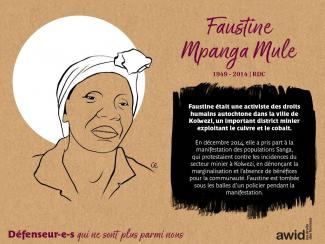

ترجمة مايا زبداوي
Sanyu es una feminista que reside en Nairobi (Kenia). Ha dedicado los últimos 10 años a apoyar a los movimientos obreros, feministas y por los derechos humanos, promoviendo la rendición de cuentas empresarial, la justicia económica y la justicia de género. Ha trabajado con el Centro de Información sobre Empresas y Derechos Humanos, en International Women’s Rights Action Watch Asia y el Pacífico (IWRAW, Observatorio Internacional de los Derechos de las Mujeres) y la Iniciativa de Derechos Humanos de la Commonwealth. Posee una maestría en Leyes y Derechos Humanos y una licenciatura en Derecho de la Universidad de Nottingham. Sus escritos se han publicado en el Business and Human Rights Journal, Human Rights Law Review, y plataformas como Open Global Rights, Democracia Abierta, entre otras. En sus ratos libres, le gusta caminar por el bosque y perseguir mariposas.
Related content
The Guardian: Kate Millett Obituary
New York Times: Kate Millett, Ground-Breaking Feminist Writer, Is Dead at 82
The New Yorker: A Last Interview with Kate Millett
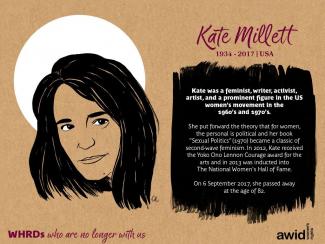
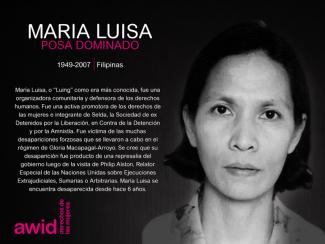
Veena Singh est une insulaire fidjienne, une féministe et une femme de couleur. Veena est née,a grandi dans une petite ville rurale aux Fidji et s a des origines ethniques mixtes (sa mère est une femme autocthone fidjienne, son père fidjien d’ascendence indienne) . Elle est professionnelle féministe du développement et une ardente défenseuse de « l’évolution des pouvoirs pour créer un changement positif » ainsi que de la « construction d'une économie de la bienveillance ». Ses expériences professionnelles se concentrent principalement dans les secteurs des droits humains, de l'égalité de genre et de l'inclusion sociale. Elle dispose de plus de 18 ans d'expérience de travail spécifique sur les droits des femmes et des enfants, les femmes, la paix et la sécurité (RCSNU 1325), la sécurité humaine, le développement et les médias communautaires. Veena a travaillé et a été bénévole au sein de plusieurs organisations non gouvernementales (ONG) basées aux Fidji avant de rejoindre SPC-Fiji Women's Rights Movement (Mouvement des droits des femmes aux Fidji), FemLINKPacific , la Croix rouge des Fidji et Save the Children (Fidji) .
Veena a en plus travaillé sur un large spectre de domaines et de problématiques de développement, dont l'accès à la justice, la prévention des conflits et la consolidation de la paix, la santé et les droits sexuels et reproductifs (SDSR), la participation politique des femmes, leur leadership et leur prise de décision, et plus récemment dans le champ des statistiques de genre. Grâce à son travaille, elle a pu étroitement collaborer avec des professionnel·le·s du développement, des féministes, des activistes, des représentant·e·s gouvernementaux·ales et des agent·e·s de la paix dans les régions du Pacifique, de l'Asie, de l'Europe et de l'Afrique. En dehors du bureau, elle aime travailler à la promotion et à la protection de l'environnement; sensibiliser à la santé mentale et au bien-être positif, et passer du temps à écrire.
Elle est maman de 11 chats, fière porteuse de saris et collectionneuse de cartes postales. Veena observe de manière réfléchie l'orientation des activités féministes aux Fidji et dans ses propres organisations, et cherche, comme elle le décrit, « à décoloniser son esprit et le 'soi' par une autoréflexion radicale ». Mais surtout, et en premier lieu, il lui importe de publier des écrits plus parlants qui la relieront à la diaspora du Pacifique. Veena est titulaire d'un diplôme en développement communautaire de l'Université Murdoch (en Australie) et d'un diplôme de troisième cycle en politique sociale de l'Université nationale des Fidji.
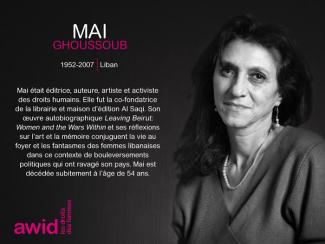
Upasana es unx ilustradorx y artista no binarie de Calcuta, India. Su obra explora narrativas identitarias y personales, que empean restos o evidencias visuales de los contextos con los que trabaja. Le atraen especialmente los diseños en patrones que, para ellx, comunican verdades complejas sobre el pasado, el presente y el futuro. Cuando Upasana no está ilustrando, organiza y dirige un centro de arte comunitario queer y trans de la ciudad.
Caroline has periodically been with AWID, previously organized the 2005 and 2008 forums in Bangkok and Cape Town, and served in other roles organizationally. Prior to joining AWID, she taught undergraduate English, then left Academia to run the Toronto Reel Asian International Film Festival and work on other projects. Most recently, she served as Operations Lead at Spring Strategies. Outside of work, Caroline can usually be found in her garden, communing with her beloved plants, and making peace with the insects and visiting rodents.
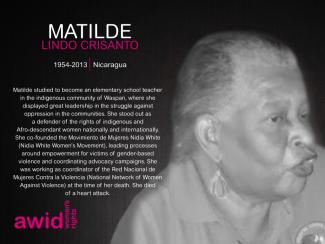
En partenariat avec de jeunes activistes féministes et des organisations dirigées par des jeunes, l'AWID co-organise Beijing sans Entraves en parallèle et indépendamment de Beijing + 25.
Alexandra es una feminista anglo-colombiana con más de 20 años de experiencia en programas locales, nacionales e internacionales sobre VIH y salud y derechos sexuales y reproductivos. Posee amplia experiencia en movilización de recursos y en relaciones con los donantes con fundaciones filantrópicas privadas y organismos multilaterales en nombre de ONG internacionales, nacionales y locales, sobre todo en América Latina y el Caribe. Antes de AWID, Alexandra trabajó en la Fundación Si Mujer, que presta servicios de aborto feminista, y como educadora en Colombia, RedTraSex y la International HIV/AIDS Alliance.
Es Licenciada en Relaciones Internacionales y Estudios para el Desarrollo de la Universidad de Sussex y posee un Máster en Salud Pública de la Escuela de Higiene y Medicina Tropical de Londres. En los pocos momentos en que no está trabajando o maternando, adora practicar natación, comer y, recientemente, comenzó a jugar al Zelda: Breath of the Wild con su hijo.
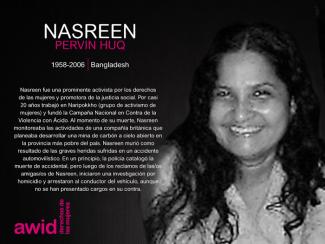
Hakima Abbas, AWID
"We're using the tools that we have to share our resistance, strategies and continue to build our power to take action and create new brave and just worlds."